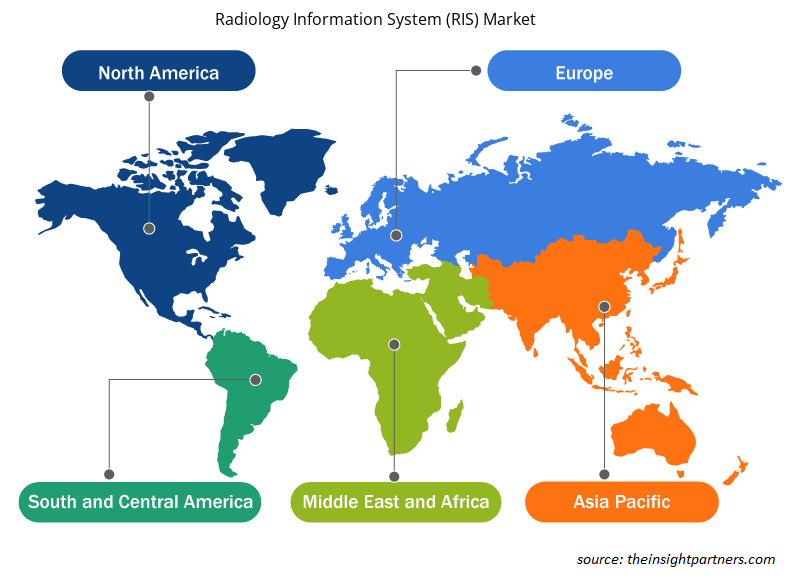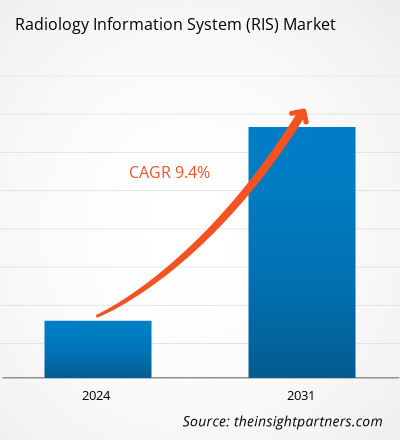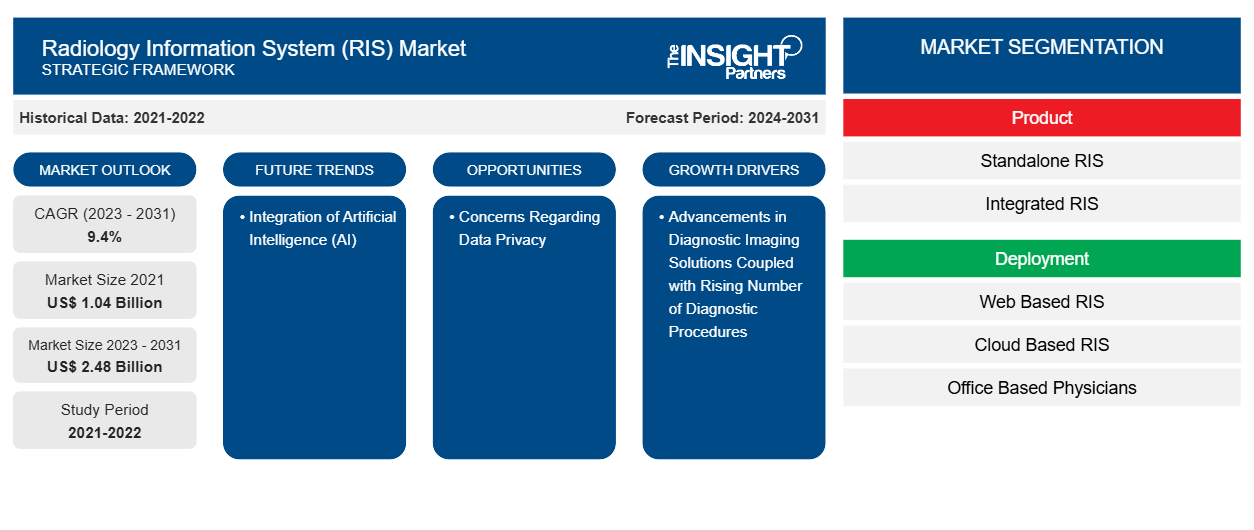Français La taille du marché des systèmes d'information radiologique (RIS) en 2021 s'élevait à 1,04 milliard USD et devrait atteindre 2,48 milliards USD d'ici 2031, contre XX milliards USD en 2023. Le marché devrait enregistrer un TCAC de 9,4 % en 2023-2031. La sensibilisation croissante aux systèmes d'information radiologique (RIS) avec leurs risques sanitaires moindres et leur taux d'adoption dans les régions en développement devraient rester les principales tendances du marché des systèmes d'information radiologique (RIS).
Analyse du marché des systèmes d'information radiologique (RIS)
Les principaux facteurs de croissance du marché comprennent l'augmentation des taux d'incidence des maladies chroniques, l'accès aux systèmes informatiques de santé et le financement public de la recherche sur le cancer. En outre, le fardeau des maladies chroniques augmente dans le monde entier, associé au vieillissement croissant de la population, et les troubles liés au mode de vie tels que le cancer, l'arthrite, les maladies cardiovasculaires et le diabète sont quelques-uns des principaux facteurs responsables de la croissance de ce marché. Une augmentation des cas de cancer devrait conduire à une concentration accrue sur les services de radiologie pour un diagnostic approprié, ce qui devrait augmenter la demande de systèmes d'information radiologique. L'augmentation des maladies chroniques telles que le cancer stimule la demande de systèmes d'information radiologique. Cependant, le coût d'installation élevé et le manque de main-d'œuvre qualifiée devraient entraver la croissance du marché au cours de la période d'étude.
Aperçu du marché des systèmes d'information radiologique (RIS)
RIS est un logiciel de santé spécialisé conçu pour gérer et rationaliser les opérations des centres de radiologie et d'imagerie. Le RIS stocke, gère et distribue les images radiologiques , les informations sur les patients et les données associées. Les avancées technologiques continues, notamment l'apprentissage automatique, l'apprentissage profond et l'intégration de l'IA dans les soins de santé, amélioreront la précision et l'efficacité des systèmes de radiologie. En outre, la demande croissante de solutions de santé intégrées pour améliorer les soins aux patients et rationaliser les flux de travail conduit à l'adoption du RIS. Les réglementations et initiatives gouvernementales favorisent également la normalisation des données et des dossiers médicaux. Elles offrent également des incitations à l'adoption de services informatiques de santé, qui devraient avoir un impact positif sur les opportunités de croissance du marché.
Personnalisez ce rapport en fonction de vos besoins
Vous bénéficierez d'une personnalisation gratuite de n'importe quel rapport, y compris de certaines parties de ce rapport, d'une analyse au niveau des pays, d'un pack de données Excel, ainsi que d'offres et de remises exceptionnelles pour les start-ups et les universités.
-
Obtenez les principales tendances clés du marché de ce rapport.Cet échantillon GRATUIT comprendra une analyse de données, allant des tendances du marché aux estimations et prévisions.
Moteurs et opportunités du marché des systèmes d'information radiologique (RIS)
Les progrès des solutions d'imagerie diagnostique devraient favoriser le marché
L'introduction de l'imagerie numérique a transformé le domaine de la radiologie. Elle a catalysé la transition de l'imagerie traditionnelle sur film vers les formats numériques, optimisé la gestion des données et augmenté l'accessibilité. Le traitement numérique des images a également conduit à des améliorations significatives de la qualité de l'image. Le RIS permet au personnel de santé de fixer des rendez-vous pour les personnes hospitalisées et ambulatoires. La radiologie a progressé vers une gestion informatisée dans le service de santé et a répondu à la demande d'une communication rentable et rapide entre les services de radiologie et leurs utilisateurs. Au cours des dernières années, divers développements ont été réalisés dans les modalités d'imagerie dans le domaine des soins de santé à des fins de diagnostic. Ces dernières années, de nombreuses avancées ont été réalisées dans le domaine de la radiographie numérique , notamment l'interprétation des rayons X assistée par l'IA, l'imagerie à double énergie, la tomosynthèse, le diagnostic assisté par ordinateur, l'assemblage automatique d'images et la radiographie mobile numérique. Ces avancées ont permis d'améliorer la qualité de l'image, contribuant ainsi à améliorer les soins aux patients et à obtenir de meilleurs résultats pour les patients. De plus, l'utilisation de la radiographie numérique réduit le besoin de répétition de l'imagerie, ce qui présente l'avantage d'une exposition aux rayonnements plus faible.
Adoption croissante des services informatiques de santé dans les économies émergentes – Une opportunité pour la croissance du marché des systèmes d’information radiologique (RIS)
À l’échelle mondiale, les services de radiologie ont de plus en plus besoin d’adopter des technologies pour répondre à la demande. L’avenir du SRI réside dans l’utilisation de l’intelligence artificielle (IA) et de l’apprentissage automatique (AM). Les algorithmes d’IA peuvent aider les radiologues à analyser les images, à détecter les anomalies et à soutenir les décisions. Les algorithmes d’AM peuvent apprendre en continu à partir de quantités massives de données et à affiner les diagnostics et les plans de traitement. L’amélioration de la connectivité grâce à Internet et à la technologie mobile, à la téléradiologie, à l’intelligence artificielle, aux développements de l’informatique d’imagerie médicale et aux appareils d’imagerie médicale portables ou mobiles peut permettre aux sites éloignés de n’importe quel pays d’accéder à de meilleurs soins de santé et diagnostics. En outre, dans les pays en développement, les systèmes de santé deviennent plus conviviaux sur le plan technologique, car les pays connaissent une internationalisation des soins en tant que marques établies. Par exemple, la Cleveland Clinic basée aux États-Unis a étendu ses marchés aux Émirats arabes unis, et la start-up anglaise Babylon, une application de diagnostic de soins primaires alimentée par l’apprentissage automatique et l’IA, est entrée en Chine et au Rwanda.
Analyse de segmentation du rapport sur le marché des systèmes d'information radiologique (RIS)
Les segments clés qui ont contribué à l’élaboration de l’analyse du marché des systèmes d’information radiologique (RIS) sont le produit, le déploiement, le composant et l’utilisateur final.
- En fonction du produit, le marché des systèmes d'information radiologique (RIS) est divisé en RIS autonomes et RIS intégrés. En 2023, le segment RIS intégré détenait la plus grande part du marché, et le même segment devrait enregistrer le TCAC le plus élevé au cours de la période de prévision.
- En termes de déploiement, le marché est segmenté en RIS basés sur le Web, RIS basés sur le cloud et RIS sur site. En 2023, le segment RIS basé sur le Web détenait la plus grande part du marché. Cependant, le segment RIS basé sur le cloud devrait enregistrer le TCAC le plus élevé au cours de la période 2023-2031.
- En fonction des composants, le marché des systèmes d'information radiologique (RIS) est classé en matériel, logiciels et services. En 2023, le segment des services détenait la plus grande part du marché, et le segment des logiciels devrait enregistrer le TCAC le plus élevé au cours de la période de prévision.
- En termes d'utilisateur final, le marché est segmenté en médecins exerçant en cabinet, en hôpitaux et en prestataires de services de santé d'urgence. En 2023, le segment des hôpitaux détenait la plus grande part du marché, et le même segment devrait enregistrer le TCAC le plus élevé au cours de la période de prévision.
Analyse des parts de marché des systèmes d'information radiologique (RIS) par zone géographique
La portée géographique du rapport sur le marché des systèmes d’information radiologique (RIS) est principalement divisée en cinq régions : Amérique du Nord, Asie-Pacifique, Europe, Moyen-Orient et Afrique, et Amérique du Sud/Amérique du Sud et centrale.
L'Amérique du Nord domine le marché des systèmes d'information radiologique (RIS). La demande pour le marché dans la région devrait connaître une croissance significative en raison de plusieurs facteurs tels que l'investissement gouvernemental dans les infrastructures de santé, la sensibilisation croissante à l'imagerie médicale ainsi que les avantages associés à la mise en œuvre du RIS. Aux États-Unis, des facteurs tels que le grand nombre de centres d'imagerie dans cette région, le rythme rapide des avancées technologiques, la croissance de la population gériatrique et la demande croissante de diagnostic assisté par ordinateur sont quelques-uns des principaux moteurs de croissance de ce marché. En outre, la présence de diverses entreprises engagées dans le développement de systèmes avancés de RIS pour l'imagerie diagnostique cardiovasculaire, orthopédique, dentaire et oncologique devrait offrir des opportunités de croissance pour la croissance du marché. Cependant, l'Asie-Pacifique devrait connaître le TCAC le plus élevé dans les années à venir en raison de facteurs tels que la croissance de l'industrie des technologies de l'information sur la santé dans cette région en raison de l'amélioration des infrastructures de santé et de l'augmentation du taux d'adoption des techniques de soins de santé avancées par les consommateurs.
Aperçu régional du marché des systèmes d'information radiologique (RIS)
Les tendances et facteurs régionaux influençant le marché des systèmes d’information radiologique (RIS) tout au long de la période de prévision ont été expliqués en détail par les analystes d’Insight Partners. Cette section traite également des segments et de la géographie du marché des systèmes d’information radiologique (RIS) en Amérique du Nord, en Europe, en Asie-Pacifique, au Moyen-Orient et en Afrique, ainsi qu’en Amérique du Sud et en Amérique centrale.

- Obtenez les données régionales spécifiques au marché des systèmes d'information radiologique (RIS)
Portée du rapport sur le marché des systèmes d'information radiologique (RIS)
| Attribut de rapport | Détails |
|---|---|
| Taille du marché en 2021 | 1,04 milliard de dollars américains |
| Taille du marché d'ici 2031 | 2,48 milliards de dollars américains |
| Taux de croissance annuel composé mondial (2023-2031) | 9,4% |
| Données historiques | 2021-2022 |
| Période de prévision | 2024-2031 |
| Segments couverts |
Par produit
|
| Régions et pays couverts |
Amérique du Nord
|
| Leaders du marché et profils d'entreprises clés |
|
Densité des acteurs du marché des systèmes d'information radiologique (RIS) : comprendre son impact sur la dynamique des entreprises
Le marché des systèmes d'information radiologique (RIS) connaît une croissance rapide, tirée par la demande croissante des utilisateurs finaux en raison de facteurs tels que l'évolution des préférences des consommateurs, les avancées technologiques et une plus grande sensibilisation aux avantages du produit. À mesure que la demande augmente, les entreprises élargissent leurs offres, innovent pour répondre aux besoins des consommateurs et capitalisent sur les tendances émergentes, ce qui alimente davantage la croissance du marché.
La densité des acteurs du marché fait référence à la répartition des entreprises ou des sociétés opérant sur un marché ou un secteur particulier. Elle indique le nombre de concurrents (acteurs du marché) présents sur un marché donné par rapport à sa taille ou à sa valeur marchande totale.
Les principales entreprises opérant sur le marché des systèmes d'information radiologique (RIS) sont :
- Royal Philips NV,
- Siemens Healthineers SA,
- Bayer SA,
- Société Cerner,
- Compagnie Générale d'Électricité,
- SOCIÉTÉ McKESSON,
Avis de non-responsabilité : les sociétés répertoriées ci-dessus ne sont pas classées dans un ordre particulier.

- Obtenez un aperçu des principaux acteurs du marché des systèmes d'information radiologique (RIS)
Actualités et développements récents du marché des systèmes d'information radiologique (RIS)
Le marché des systèmes d'information radiologique (RIS) est évalué en collectant des données qualitatives et quantitatives après des recherches primaires et secondaires, qui comprennent des publications d'entreprise importantes, des données d'association et des bases de données. Voici une liste des évolutions du marché des systèmes d'information radiologique (RIS) :
- Royal Solutions Group, l'un des principaux fournisseurs de logiciels de santé, est heureux d'annoncer l'élargissement de son partenariat avec Concord Technologies. L'intégration de technologies supplémentaires issues de la suite Practical AI de Concord, composée de solutions de traitement de données de pointe, permet de numériser facilement les notes dactylographiées et manuscrites, puis d'extraire les données et de les intégrer aux flux de travail. Cela promet de transformer la façon dont les cabinets médicaux gèrent la saisie des commandes, l'indexation et l'autorisation préalable. En automatisant ces processus critiques, les professionnels de la santé sont en mesure de se concentrer sur les soins aux patients plutôt que sur la paperasse. (Royal Solutions Group, LLC, communiqué de presse, 2024)
- Manipal Hospitals, l'un des principaux prestataires de soins de santé en Inde, a conclu un accord avec FUJIFILM India. Dans le cadre de cet accord à long terme, Manipal Hospitals se verrait doté d'un système d'archivage et de communication d'images à grande échelle (PACS), optimisé par FUJIFILM India. Le PACS élimine le besoin de stocker, de récupérer et d'envoyer manuellement des informations sensibles, des films et des rapports. (FUJIFILM India Private Limited, News, 2023)
- PARATUS acquiert une participation majoritaire dans IMAGE Information Systems. IMAGE est un fournisseur leader de PACS au service des centres d'imagerie et des hôpitaux du monde entier. Cet investissement de PARATUS est un élément stratégique de la création d'un fournisseur mondial de premier plan de logiciels et de services informatiques pour le secteur de la santé. (RADiQ IMAGE Information Systems, News, 2023)
- Philips lance de nouvelles solutions informatiques améliorées par l'IA pour accroître la confiance diagnostique grâce à l'intelligence à chaque étape du flux de travail radiologique à la RSNA. (Koninklijke Philips NV, News, 2022)
Rapport sur le marché des systèmes d'information radiologique (RIS) : couverture et livrables
Le rapport « Taille et prévisions du marché des systèmes d’information radiologique (RIS) (2021-2031) » fournit une analyse détaillée du marché couvrant les domaines ci-dessous :
- Taille du marché et prévisions aux niveaux mondial, régional et national pour tous les segments de marché clés couverts par le périmètre
- Dynamique du marché, comme les facteurs moteurs, les contraintes et les opportunités clés
- Principales tendances futures
- Analyse détaillée des cinq forces de PEST/Porter et SWOT
- Analyse du marché mondial et régional couvrant les principales tendances du marché, les principaux acteurs, les réglementations et les développements récents du marché
- Analyse du paysage industriel et de la concurrence couvrant la concentration du marché, l'analyse de la carte thermique, les principaux acteurs et les développements récents
- Profils d'entreprise détaillés
- Analyse historique (2 ans), année de base, prévision (7 ans) avec TCAC
- Analyse PEST et SWOT
- Taille du marché Valeur / Volume - Mondial, Régional, Pays
- Industrie et paysage concurrentiel
- Ensemble de données Excel
Rapports récents
Témoignages
Raison d'acheter
- Prise de décision éclairée
- Compréhension de la dynamique du marché
- Analyse concurrentielle
- Connaissances clients
- Prévisions de marché
- Atténuation des risques
- Planification stratégique
- Justification des investissements
- Identification des marchés émergents
- Amélioration des stratégies marketing
- Amélioration de l'efficacité opérationnelle
- Alignement sur les tendances réglementaires























 Obtenez un échantillon gratuit pour - Marché des systèmes d'information radiologique (RIS)
Obtenez un échantillon gratuit pour - Marché des systèmes d'information radiologique (RIS)